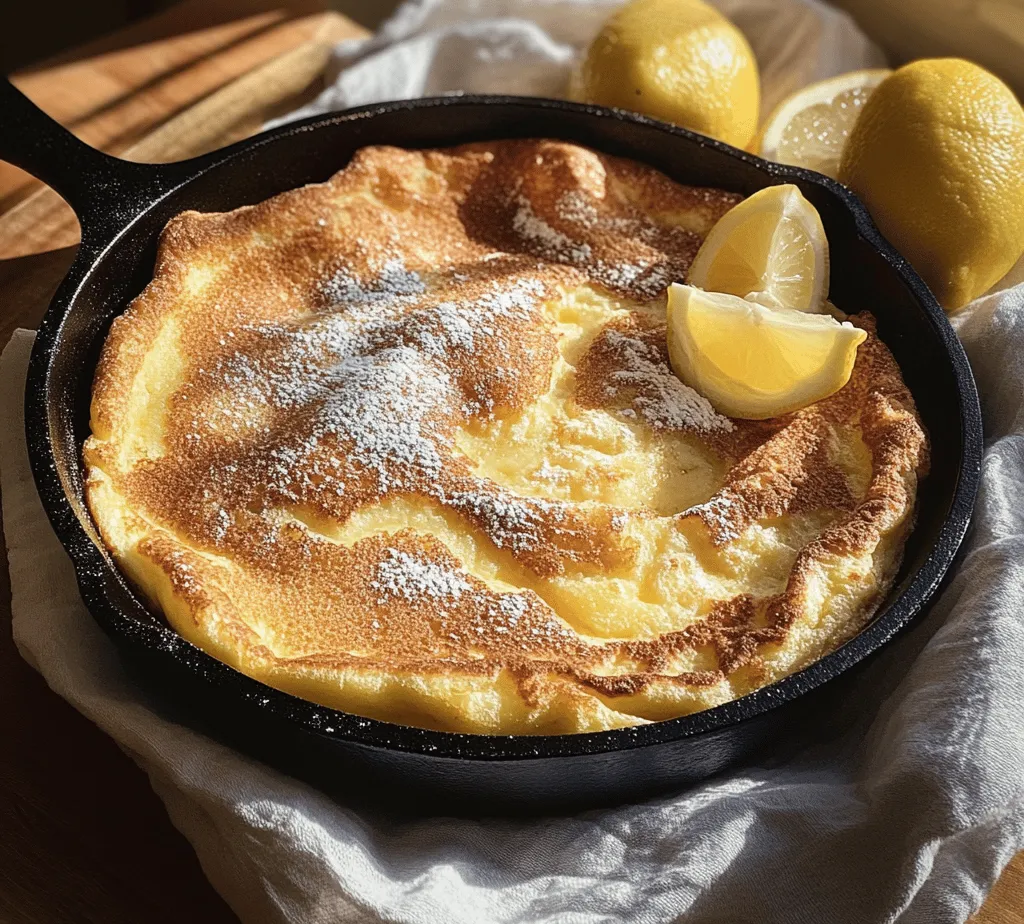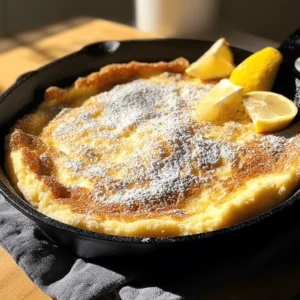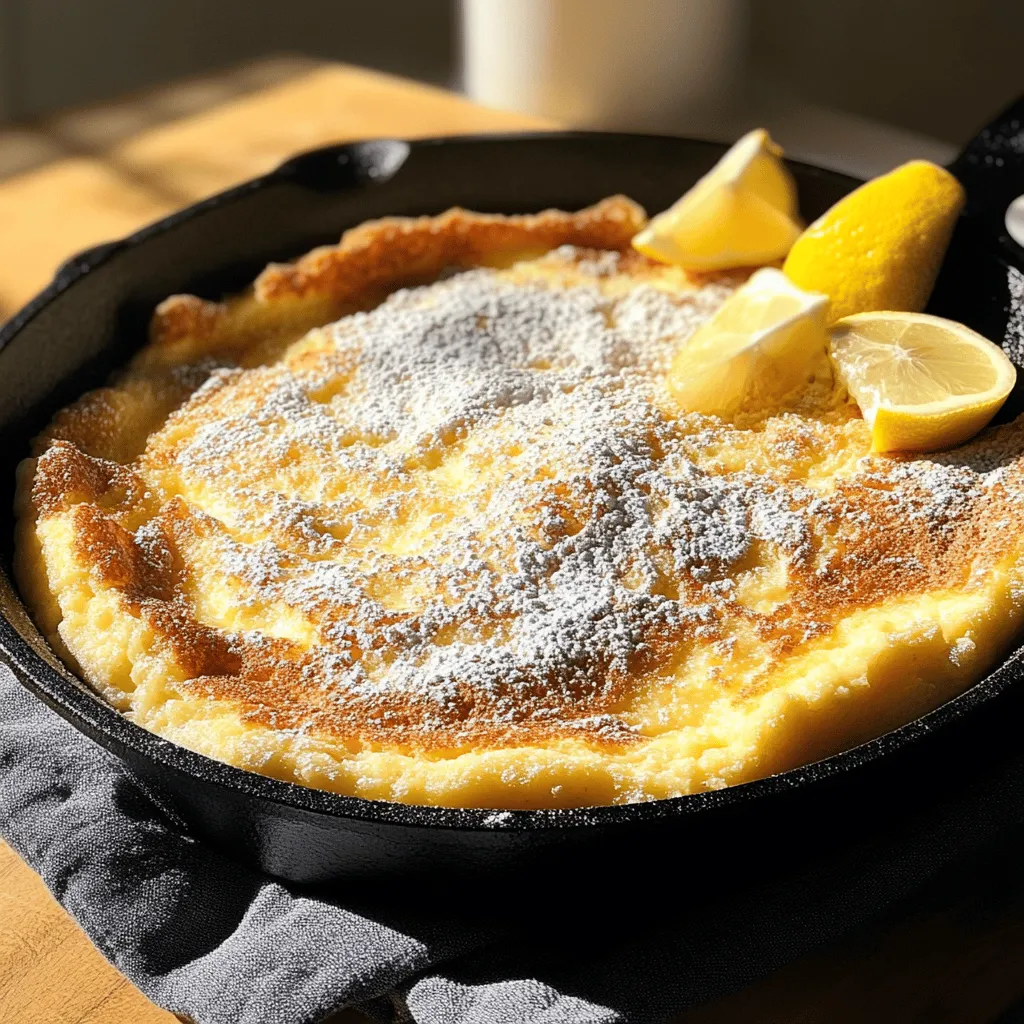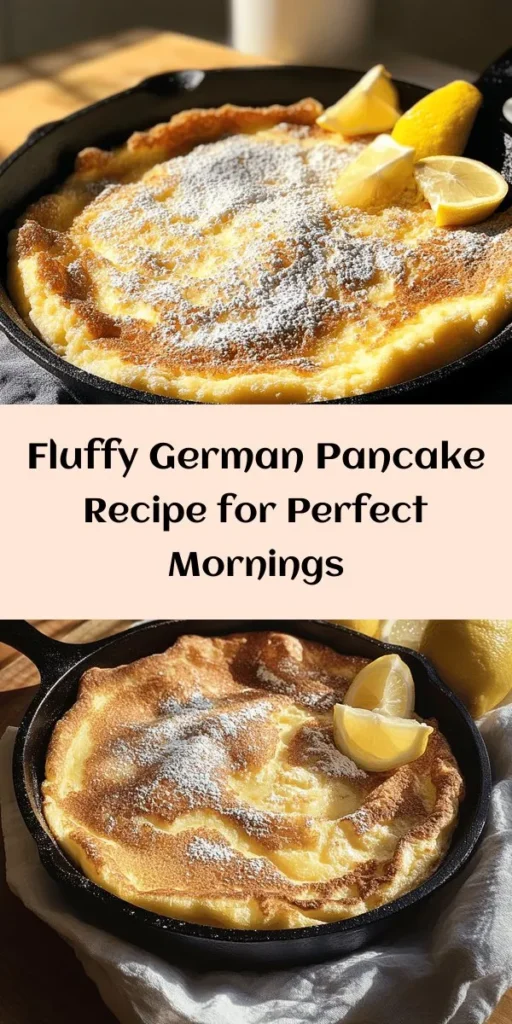Introduction
German pancakes, known for their airy and light texture, have been captivating breakfast lovers for generations. Unlike your typical pancake, which is cooked on a griddle, the German pancake is baked in the oven, resulting in a delightful puffiness that can only be achieved through this unique cooking method. This recipe offers a simple yet satisfying approach to making these fluffy delights, perfect for breakfast or brunch occasions. With just a few ingredients, you can whip up a dish that is not only visually impressive but also incredibly delicious.
What sets baked German pancakes apart from their traditional counterparts is their texture and preparation. While regular pancakes tend to be flat and require constant flipping, German pancakes rise dramatically as they bake, creating a golden-brown exterior that encases a soft, custardy interior. They are often served with a dusting of powdered sugar and a squeeze of fresh lemon juice, making them a refreshing treat to start your day.
In this article, we will delve into the simplicity of making Fluffy Baked German Pancakes, guiding you through the essential ingredients and step-by-step instructions to ensure a flawless outcome. Get ready to impress your family and friends with a breakfast that looks as good as it tastes!
Understanding German Pancakes
Historical Background
German pancakes, also known as Dutch babies, have a rich history that dates back to the early 1900s in the United States. Although their name suggests a direct connection to Germany, the dish’s origins are somewhat ambiguous. Many believe that the name “Dutch baby” was a mispronunciation of “Deutsch,” which translates to “German” in English. This delightful breakfast dish is thought to have been inspired by the German Apfelpfannkuchen, a baked apple pancake that has been enjoyed for centuries.
The popularity of German pancakes skyrocketed in the mid-20th century, particularly in America, where they became a staple in many households. Their ease of preparation and impressive presentation made them a favorite for special occasions and family gatherings. Today, they are often featured on brunch menus across the country, showcasing their enduring appeal.
Differences Between German Pancakes and Other Types of Pancakes
While all pancakes share a similar base of flour, eggs, and liquid, German pancakes stand apart due to their unique cooking method and texture. Regular pancakes are cooked on a stovetop and are typically smaller and thicker, while German pancakes are poured into a hot, buttered baking dish and baked in the oven.
This baking process allows the pancake to rise significantly, creating a dramatic puff that collapses slightly upon exiting the oven. The result is a pancake that is crispy on the edges and soft and custardy in the center. Additionally, German pancakes are often larger and can be sliced into wedges, making them easy to share among multiple diners.
Cultural Significance
In Germany, pancakes hold a special place in the culinary landscape. They are often enjoyed as a dessert, filled with fruits or sweet fillings, as well as a breakfast option. In many households, the preparation of pancakes is a cherished tradition, passed down through generations. German pancakes can be found in various forms, each region offering its own twist on the classic recipe.
In America, the German pancake has taken on a life of its own, evolving from its European roots into a beloved brunch dish. The versatility of German pancakes allows for an array of toppings, from fresh fruits and syrups to whipped cream and nuts, making them a customizable delight for all palates.
Essential Ingredients for Fluffy Baked German Pancakes
Creating the perfect Fluffy Baked German Pancakes requires a few essential ingredients. Each component plays a crucial role in achieving that signature fluffiness and flavor. Below is a breakdown of the key ingredients you’ll need for this recipe:
Eggs
Eggs are the backbone of any pancake recipe, but they play an even more pivotal role in German pancakes. The eggs give the pancake its structure and stability while also contributing to its airy texture. When beaten and combined with the other ingredients, they help create a light and fluffy batter that puffs beautifully in the oven.
Whole Milk
Whole milk adds moisture and richness to the batter, ensuring that the resulting pancake is soft and creamy. The fat content in whole milk aids in providing a tender crumb, balancing the structure created by the eggs. For an even richer flavor, you can substitute the whole milk with buttermilk, which also adds a slight tanginess to the dish.
All-Purpose Flour
All-purpose flour serves as the foundation of the pancake batter. It provides the necessary gluten structure, helping the pancake to rise while maintaining its shape. When combined with the wet ingredients, the flour absorbs moisture and contributes to the overall texture of the finished pancake.
Granulated Sugar
A touch of granulated sugar is added to the batter to enhance the sweetness of the pancakes. Sugar not only contributes to the flavor but also aids in the browning process, giving the pancake its appealing golden color. For a less sweet option, you can reduce the sugar or replace it with a natural sweetener like honey or maple syrup.
Vanilla Extract
Vanilla extract elevates the flavor profile of the pancakes, adding a warm and aromatic note that complements the other ingredients beautifully. Using pure vanilla extract is highly recommended for the best results. If you want to experiment with flavors, consider using almond extract or a splash of citrus zest for a unique twist.
Salt
A pinch of salt is essential to balance the sweetness and enhance the overall flavor of the pancakes. Salt helps to bring out the natural flavors of the other ingredients, making each bite more delicious. It’s a small but crucial component in any pancake recipe.
Unsalted Butter
Unsalted butter is used to grease the baking dish and provides richness and flavor to the pancakes. The butter not only helps prevent sticking during baking but also contributes to the golden-brown crust that forms on the edges of the pancake. For a healthier alternative, you can use coconut oil or a non-stick cooking spray.
Powdered Sugar and Fresh Lemon Wedges
While these toppings are not part of the batter, they are essential for serving your Fluffy Baked German Pancakes. A light dusting of powdered sugar adds a touch of sweetness and elegance to the presentation. Fresh lemon wedges provide a burst of acidity that beautifully contrasts the sweetness of the pancake, enhancing the overall experience.
Step-by-Step Instructions
Now that you have a clear understanding of the recipe’s background and its essential ingredients, it’s time to dive into the step-by-step instructions for making Fluffy Baked German Pancakes.
Step 1: Preheat the Oven
Begin by preheating your oven to 425°F (220°C). This high temperature is crucial for achieving that signature puffiness in the pancake. While the oven is heating, you can prepare the baking dish.
Step 2: Prepare the Baking Dish
Choose a 9×13-inch baking dish or a similarly sized oven-safe skillet. Add about 4 tablespoons of unsalted butter to the dish and place it in the oven to melt while it preheats. The melted butter will coat the bottom of the dish, ensuring that the pancake does not stick and develops a beautifully crispy edge.
Step 3: Whisk the Ingredients
In a mixing bowl, crack 4 large eggs and whisk them until well combined. Add 1 cup of whole milk, 1 cup of all-purpose flour, 1/4 cup of granulated sugar, 1 teaspoon of vanilla extract, and a pinch of salt. Whisk the mixture until smooth and free of lumps. The batter should be somewhat thin, which is normal for German pancakes.
Step 4: Pour the Batter
Once the oven has preheated and the butter has melted, carefully remove the baking dish from the oven. Pour the batter directly into the hot, buttered dish. Be cautious, as the dish will be hot, and the batter will sizzle upon contact with the melted butter.
Step 5: Bake the Pancake
Place the baking dish back into the oven and bake for 20-25 minutes, or until the pancake has puffed up and the edges are golden brown. Avoid opening the oven door during the baking process, as this can cause the pancake to deflate.
Step 6: Serve Immediately
Once baked, remove the pancake from the oven and let it cool for a minute before slicing it into wedges. Dust with powdered sugar and serve with fresh lemon wedges on the side for squeezing over the top.
These simple steps lead to a delightful breakfast experience that is sure to impress everyone at the table. Now that you are equipped with the knowledge to create Fluffy Baked German Pancakes, you can explore various toppings and serving suggestions to make this dish your own.
Stay tuned for the second part of this article, where we will discuss tips for achieving the best results and answer some common questions about German pancakes. Enjoy your cooking adventure!

Preheating the Oven and Preparing the Skillet
To achieve the signature rise and fluffy texture of a German pancake, the first step involves preheating your oven and preparing your skillet. Start by preheating your oven to 425°F (220°C). This high temperature is essential for creating the dramatic puff that characterizes this dish.
While the oven is heating up, get your skillet ready. A cast-iron skillet is ideal for this recipe due to its ability to retain heat evenly, but you can also use a heavy oven-safe baking dish. Place your skillet in the oven while it preheats. This step is crucial because pouring the batter into a hot skillet helps it rise quickly, creating a fluffy texture that is both light and airy. It’s important to avoid skipping this step, as a cold skillet will not produce the same impressive results.
Whisking the Batter
Once your oven and skillet are preheated, it’s time to whisk together the batter for your German pancake. In a large mixing bowl, combine the eggs, milk, flour, and a pinch of salt. Use a whisk or an electric mixer to blend the ingredients until you have a smooth and lump-free batter. This is an important step; over-mixing can lead to a denser pancake, so mix just until combined.
For best results, allow the batter to rest for about 5-10 minutes after whisking. This resting period lets the flour fully absorb the liquid, resulting in a smoother texture. If you desire, you can also enhance the flavor by adding a splash of vanilla extract or a teaspoon of cinnamon to the batter, which will give a delightful aroma as it bakes.
The Baking Process
With your batter ready, carefully remove the hot skillet from the oven. Be cautious, as the skillet will be extremely hot. Add a tablespoon of butter to the skillet, allowing it to melt and coat the bottom evenly. Once melted, immediately pour the batter into the center of the skillet.
Return the skillet to the oven and bake for about 20-25 minutes. During this time, the pancake will puff dramatically. It’s crucial not to open the oven door during the first 15 minutes of baking, as this can cause the pancake to deflate.
You’ll know your German pancake is ready to be removed from the oven when it is golden brown on the edges and has risen significantly. The center should be set and no longer jiggly. If you notice any browning happening too quickly, lower the oven temperature slightly to prevent burning.
Serving Suggestions
Once your German pancake is perfectly baked, it’s time to serve! Carefully remove it from the oven and let it cool for about a minute. Dust the top with powdered sugar for a touch of sweetness and an appealing presentation. This dusting not only enhances the visual appeal but also adds a delightful flavor contrast to the pancake’s fluffy texture.
Lemon wedges are often served alongside a German pancake. The tartness of the lemon juice complements the sweetness of the pancake beautifully. Squeeze a bit of fresh lemon juice over the pancake before serving for a refreshing burst of flavor that elevates the dish.
Tips for Perfecting Your German Pancake
Common Mistakes to Avoid While Making German Pancakes
1. Not Preheating the Skillet: This is the most crucial step. A cold skillet will lead to a flat pancake.
2. Overmixing the Batter: Mix just until combined to avoid a dense texture.
3. Opening the Oven Door Early: Keep the oven door closed to maintain the heat and allow the pancake to rise properly.
Variations and Substitutions for Dietary Preferences
If you or your guests have gluten sensitivities, you can easily make a gluten-free version of this pancake by substituting the all-purpose flour with a gluten-free flour blend. Additionally, if you’re looking to reduce dairy intake, almond milk or oat milk works well in place of regular milk without sacrificing flavor.
Customization Options
Feel free to get creative with your German pancake by adding mix-ins or toppings. Fresh fruits like blueberries, strawberries, or sliced bananas can be folded into the batter before baking. Alternatively, you can top the pancake with sautéed apples or pears for a warm, comforting twist. Nuts, such as toasted almonds or walnuts, can add a nice crunch and additional flavor.
Pairing Suggestions
To complement your fluffy baked German pancake, consider serving it with a hot beverage. Freshly brewed coffee or a fragrant tea pairs beautifully with the pancake’s sweetness. For a refreshing alternative, a glass of freshly squeezed orange juice or a fruit smoothie can elevate your breakfast experience.
In addition to beverages, you might want to serve some crispy bacon or sausage on the side. The savory flavors of the meat provide a delicious contrast to the sweet pancake, making for a well-rounded meal.
Conclusion
The fluffy baked German pancake is not only a delicious dish but also a simple one that can impress your family and friends. Its light and airy texture, combined with the ability to customize toppings, makes it an ideal breakfast treat. Whether you enjoy it with a sprinkle of powdered sugar, a squeeze of lemon, or your favorite fruits, this recipe is sure to become a favorite in your household.
We encourage you to try making this delightful dish at home. Gather your loved ones around the table, share the experience of cooking together, and enjoy the fruits of your labor. The joy of cooking and sharing meals is one of life’s greatest pleasures, and this fluffy baked German pancake is a fantastic way to create lasting memories in the kitchen.



